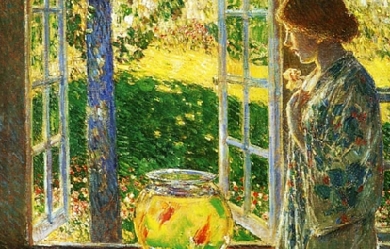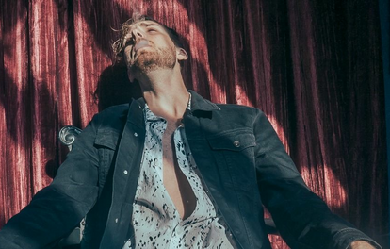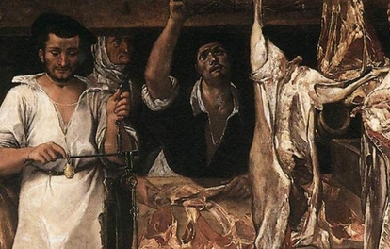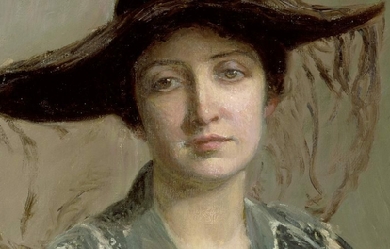Nature and Panic
Can beauty save us?
The first evidence we have of any human doings with nature other than utilitarian artifacts for hunting and fishing are the Paleolithic paintings in caves in France and Spain. These great works of art were created over a period of twenty thousand years, and then stopped; we don’t really know why they first began to be created or why they didn’t continue.
I think most of us have been tempted to play the game of trying to intuit the vast number of individuals who were born and died during those uncountable millennia and to imagine what a single person’s life, a “first person” in both senses of the term, would really have been. For me, the daydream invariably leads me to picture my poor ancestor living in almost constant fear of threats to life and well-being: the predators, the droughts, the erratic cold that sometimes descended and stayed for thousands of years, and sometimes, for reasons we still don’t understand, didn’t. “Nasty, brutish, and short,” to quote the Hobbesian cliche.
So, were those people really that much more anxious for themselves than we are? To return to the Paleolithic paintings: there’s little evidence of anguish or dread in their subject matter and execution. The creatures in them are depicted with accuracy and detail and with that breathlessly assured brushwork that could have been acquired through nothing but aesthetic dedication and love. There are almost no depictions of nature as threatening. In one painting there’s a lion, but she’s treated with a whimsical humor; in another two, someone seems to have been killed by a bison, the beginning of what some researchers suspect may have been a series of myths. The only truly malignant matters that are recorded in the caves are a few mysterious and so far uninterpreted recumbent human figures, riven with what seem to be spears: they were possibly murdered, perhaps even tortured. But generally, if the society in which these artists lived was fraught with fear, it certainly isn’t manifested in their work. Even their span of years, it turns out, wasn’t as short as was once thought: the most recent evidence suggests that people during these eras regularly lived to the age of fifty or sixty.
At the same time, if we pull back a little and consider larger currents of human existence, there does seem to have been ample reason for anxiety. The climate, as I mentioned, often dramatically changed in those epochs. There were long droughts and, at some point, the almost total dying off of reindeer, which had been humans’ primary food—with what precise consequences we probably will never know, beyond that humans somehow adapted, and survived.
And we also can’t possibly know whether any single person, or group, or group of generations would have been aware, and especially daunted, by these grim developments. Perhaps one year, winter came earlier; perhaps another year, the reindeer migrations arrived later, then not at all. Would there have been a history to contain these matters? We don’t know that either, but if there was, what would have been the emphasis of those who recorded it? Would they have been depressives, manic-depressives, optimists, pessimists?
I’ll continue on a more personal note. Like many people I know, I often have a somewhat—no, a wholly—frightening vision of the future of humanity and of our earth. There are periods when I live in a state of acute anxiety, indeed, near panic, about what awaits our children and grandchildren. Last year, I realized one day that every poem I was writing, or attempting to write, had global warming and its consequences either as its overt or implied theme. Sometimes I’m depressed beyond writing or saying anything at all; I fall into a funk that threatens never to end.
Given all the evidence that’s being accumulated about global warming and its ramifications, this seems a perfectly reasonable response to the only future in sight. However, I’ve also had to realize over the course of my life that I’m intrinsically somewhat of a depressive person, about much else besides the end of the world, and that my instinctive response to fear, or threat, or despair is to plunge deeper into the darkness that so readily takes me. It required a long time for me to notice that many people respond differently; some friends, for instance, who, when deeply concerned about large matters, can turn readily away from them to a relatively cheerful vision of existence, while I go on brooding, frightened, trembling. And certainly not unsensible public figures can manage to convey a bright vision that confounds personalities like mine. One of my favorite recent examples is Fred Kavli, a wealthy scientist philanthropist who recently established a program of million dollar prizes for scientists and who announced at the first presentation ceremony: “The future is going to be more spectacular than we can ever imagine.” I hope with all my heart that he knows something I don’t.
I’ve come to wonder lately what the implication of all this is for my life and work as an artist, a poet. Certainly the traditions of literature, particularly in the last century and a half, have had their fair share of dark personalities—more than mere pessimists, sometimes outrageous nihilists. One of my most enduring poetic influences has been Baudelaire, hardly a paragon of healthy thought. Don’t I have a right to express my own sadnesses? I have often enough, Lord knows, in the past, and I’m sure I will again, but at the same time, mightn’t there be some responsibility in my artistic endeavors I hadn’t suspected, hadn’t conceived of, until now?
Surely the most extreme vision of the future in recent literature is Cormac McCarthy’s novel The Road. McCarthy is a novelist of craft, with a powerful gift for verisimilitude, and in his book he puts all his talents at the service of the literally darkest non–science-fiction fate that has ever been conceived for human beings. The earth—land and sea—is black with soot and ash, utterly silent except for the wind, some mysterious intermittent explosions, and the several words, most of them threats, human beings still manage to pass between them, before, in many cases, they devour each other. Those of you who have read the book know that the word “grim” hardly begins to do justice to the sheer horror McCarthy inflicts on the planet, and on us, his readers.
I use the word “inflict” intentionally. I’m not the only person I know who’s expressed regret at having ingested the book: I feel sometimes indignant that I have to have it in my consciousness. If there ever was a book that embodied the extremity of the emotion we call panic, this has to be it. I find it’s like having a piercing scream in my mind, one that, when the book comes to mind, which it does more often than I’d like, goes off like a siren.
Another recent, much different, book that deals with the possible dark times ahead of us is Gretel Ehrlich’s The Future of Ice—also a book of premonition and dire prophecy. I’ll admit that when I began reading it, I thought I wouldn’t be able to go on. Ehrlich’s prognostications about the grim future in store for the world seemed mostly to consist of information I already possessed—reading it felt like watching an autopsy of a living body. As I went further into the book, though, I was taken with its intimacy, its presentation of an actual person living a real life while at the same time reflecting on so much melting away, and I found the book finally inspiring, perhaps because it doesn’t manifest the kind of annihilating cosmic panic that McCarthy’s book does. It tells of the passions and sadnesses of experiencing, having to experience, the fear of knowing what may come to us, but all of that is tempered by the dailiness of the life and loves of the author. The Future of Ice contains its own epigraph, its own enduring motto: “Beauty saves me.” Until I went back to look for the phrase to quote, I had remembered it as “Beauty saves us,” and I’ve allowed myself to keep it that way.
I find it a bit odd to be using the word “beauty” this way. I’ve never thought terribly hard about the concept, certainly not as a theoretician, which I’m emphatically not. We all, though, have ideas about what is beautiful and what isn’t, and generally we think we know why. And it is, or at least was, tempting, as a poet, to try to be an aesthetician rather than an artist: there’s an aura of immediate authority associated with the one that isn’t associated with the other. I know that at any moment I’ll be able to think and talk for five or ten minutes about beauty: I never know whether in the next five or ten minutes or five or ten years I’ll be able to create any.
Beauty won’t save the world from the depredations with which it’s already been savaged, but it can save us from the enervating despair that is the outcome of panic, that paralysis that might keep us from doing what we can to confront what’s before us. We’ll never know how our ancestors, so put upon by the enormous unknown world in which they found themselves, persevered and survived, but we do know that they bequeathed to us, and probably infused into our genes, the conviction that the dream and execution of the beautiful made the world ours in a way nothing else could.
However it happens—by whatever complex, forbiddingly imprecise, dauntingly imperfect means—all over the world, if not every day then in every age, art is created and beauty manifested: beautiful paintings and poems and pieces of music and buildings are generated. One can almost imagine small flaring lights on the surface of the earth, like those seen in photos from space, though they are much sparser and more scattered than the illuminating devices that bespeckle our globe. And then over time these embodiments of the beautiful are harvested, amassed, collected in books, in museums, in concert halls, to be distributed into the lives of individual human beings, to become crucial elements of their existence. Often, our experience of beauty will be the first hint of what each of us at some point will dare call our soul. For don’t those first stirrings of that eternally uncertain, barely grasped notion of something more than mere mind, mere thought, mere emotion usually first come to us in the line of a poem, a passage of music, or the unreal yet more than real image in a painting?
And isn’t it also the case that beauty is the one true thing we can count on in a world of insufferable uncertainty, of obdurate, relentless moral conflicts? I’ve wondered sometimes if humans invented gods not to tend to our moral or immoral selves but to have something appropriately sensitive and grand and wise enough to appreciate these miraculous modes of beauty that are so different in material and quality from anything else in the world. Might gods have first been devised not to assuage our fears and hear our complaints and entreaties but for there to be identities sufficiently sublime to understand what those first painters and sculptors, and surely, though the words and tunes have been lost, those poets and singers had wrought?
Perhaps this is why those first great art works were executed deep in caves, so as to be certain the divinities who were their audience wouldn’t be distracted by the wonder of the natural world, and so lose the concentration necessary to glory in, and be glorified by, these singular human creations that equaled and even surpassed what had been given by nature for meditation. And perhaps that’s why poets and painters, who may half-remember such matters, go off into what can look to others like solitary caverns, shadowed with loneliness, but which surely aren’t. Beauty saves us. Beauty will save us. The world, though, is still ours to cherish, and ours to protect.






